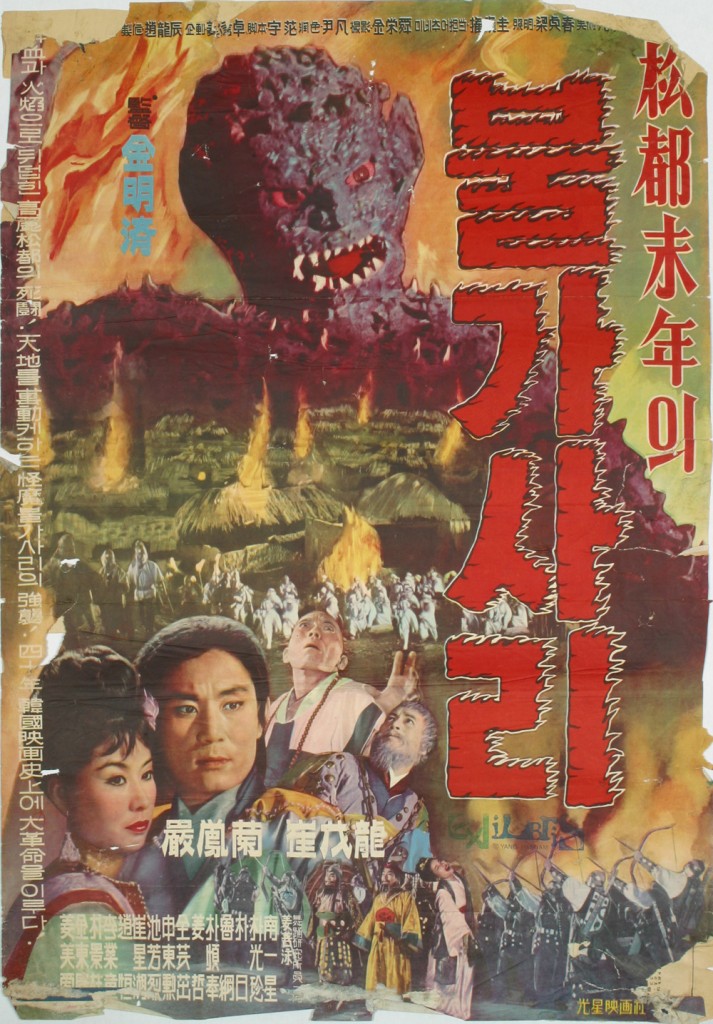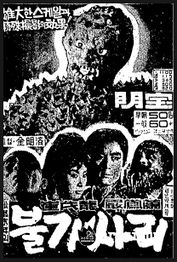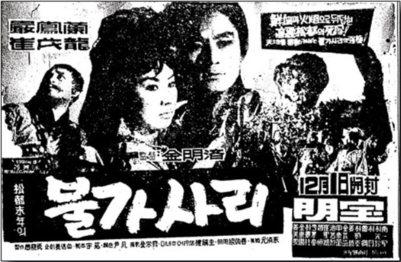Bulgasari (lost South Korean monster film; 1962): Difference between revisions
No edit summary |
No edit summary |
||
| Line 5: | Line 5: | ||
|status=<span style="color:red;">'''Lost'''</span> | |status=<span style="color:red;">'''Lost'''</span> | ||
}} | }} | ||
'''''Bulgasari''''' (Korean: ''불가사리'') is a 1962 Korean dark fantasy-action monster film directed by Kim Myeong-Jae. The film starred Choi Moo-ryong, Um Aing-ran and Gang Mi-ae and was the first time special effects were used in a Korean film. It is also considered Korea’s first science-fiction monster film.<ref>[http://www.cine21.com/news/view/?mag_id=52373 Cine21 except from a 2008 news article about an event called ''Monsters vs. Encyclopedia: Korean Monsters'' which would be held at the Korea Film Archives.] Retrieved 26 Mar '20</ref> | |||
'''''Bulgasari''''' (Korean: 불가사리 | |||
==Summary== | ==Summary== | ||
During the later years of Goryeo Dynasty (918-1392), a talented martial artist is murdered. His resentment | During the later years of the Goryeo Dynasty (918-1392), a talented martial artist is murdered. His anger and resentment make him be born again as Bulgasari, a monster that grinds and eats up iron. The monster takes his revenge on the traitors responsible for his death. | ||
==Availability== | ==Reception/Availability== | ||
Before the film was released, critics unanimously wrote negative reviews about the film, writing that "historical fins were the only spectacles worth watching", and used language like "childish" and "trashy".<ref>[https://newslibrary.chosun.com/view/article_view.html?id=1279819621207m1082&set_date=19621207&page_no=8 Page 8 of the Chosun Ilbo from December 7th, 1962, which had a review for ''Bulgasari''.] Retrieved 26 Mar '20</ref> | |||
The film is considered lost mainly due to the Korean War. It is listed on the List of lost films on the World Heritage Encyclopedia.<ref>[http://self.gutenberg.org/articles/eng/List_of_lost_films World Heritage Encyclopedia page on its "List of Lost Films".] Retrieved 26 Mar '20</ref> The image of the Bulgasari creature accompanying the review is the only known still from the movie to exist, although the image later reappeared in various posters said to be the originals. That image that was on the "original" posters were reused, mirrored, and modified, which might mean that the marketing materials are actually fanmade. | |||
==Gallery== | ==Gallery== | ||
| Line 39: | Line 21: | ||
File:Bulgasari BW.PNG|Additional Black and white poster. | File:Bulgasari BW.PNG|Additional Black and white poster. | ||
</gallery> | </gallery> | ||
==External Link== | |||
*[https://www.imdb.com/title/tt9815476/plotsummary?ref_=tt_ov_pl IMDb plot summary from ''Bulgasari''.] Retrieved 26 Mar '20 | |||
==References== | ==References== | ||
Revision as of 16:55, 28 March 2020
Bulgasari (Korean: 불가사리) is a 1962 Korean dark fantasy-action monster film directed by Kim Myeong-Jae. The film starred Choi Moo-ryong, Um Aing-ran and Gang Mi-ae and was the first time special effects were used in a Korean film. It is also considered Korea’s first science-fiction monster film.[1]
Summary
During the later years of the Goryeo Dynasty (918-1392), a talented martial artist is murdered. His anger and resentment make him be born again as Bulgasari, a monster that grinds and eats up iron. The monster takes his revenge on the traitors responsible for his death.
Reception/Availability
Before the film was released, critics unanimously wrote negative reviews about the film, writing that "historical fins were the only spectacles worth watching", and used language like "childish" and "trashy".[2]
The film is considered lost mainly due to the Korean War. It is listed on the List of lost films on the World Heritage Encyclopedia.[3] The image of the Bulgasari creature accompanying the review is the only known still from the movie to exist, although the image later reappeared in various posters said to be the originals. That image that was on the "original" posters were reused, mirrored, and modified, which might mean that the marketing materials are actually fanmade.
Gallery
External Link
- IMDb plot summary from Bulgasari. Retrieved 26 Mar '20
References
- ↑ Cine21 except from a 2008 news article about an event called Monsters vs. Encyclopedia: Korean Monsters which would be held at the Korea Film Archives. Retrieved 26 Mar '20
- ↑ Page 8 of the Chosun Ilbo from December 7th, 1962, which had a review for Bulgasari. Retrieved 26 Mar '20
- ↑ World Heritage Encyclopedia page on its "List of Lost Films". Retrieved 26 Mar '20



